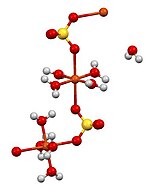Liû-sng tâng(II)
- Liû-sng tâng ū kî-tha ê ì-sù, chhiáⁿ-khoàⁿ: Liû-sng tâng
Liû-sng tâng(II) sī tâng ê 1 khoán liû-sng-iâm, hoà-ha̍k-sek sī CuSO4.
| |||
| Hō-miâ | |||
|---|---|---|---|
| IUPAC hō-miâ
Copper(II) sulfate
| |||
| Kî-tha hō-miâ
Cupric sulphate
Blue vitriol (pentahydrate) Bluestone (pentahydrate) Bonattite (trihydrate mineral) Boothite (heptahydrate mineral) Chalcanthite (pentahydrate mineral) Chalcocyanite (mineral) | |||
| Sek-pia̍t-hō | |||
| |||
3D model (JSmol)
|
|||
| ChEBI | |||
| ChEMBL | |||
| ChemSpider | |||
| ECHA InfoCard | 100.028.952 | ||
| EC Number | 231-847-6 | ||
| KEGG | |||
PubChem CID
|
|||
| RTECS number | GL8800000 (anhydrous) GL8900000 (pentahydrate) | ||
| UNII | |||
| |||
| |||
| Sèng-chit | |||
| CuSO4 (anhydrous) CuSO4·5H2O (pentahydrate) | |||
| Mole chit-liōng | 159.609 g/mol (anhydrous)[1] 249.685 g/mol (pentahydrate)[1] | ||
| Gōa-māu | gray-white (anhydrous) blue (pentahydrate) | ||
| Bi̍t-tō͘ | 3.60 g/cm3 (anhydrous)[1] 2.286 g/cm3 (pentahydrate)[1] | ||
| Iûⁿ-tiám | 110 °C (230 °F; 383 K) decomposes (·5H2O)[1] <560 °C decomposes[1] | ||
| 1.055 molal (10 °C) 1.26 molal (20 °C) 1.502 molal (30 °C)[2] | |||
| Iûⁿ-kái-tō͘ | anhydrous insoluble in ethanol[1] pentahydrate soluble in methanol[1] 10.4 g/L (18 °C) insoluble in ethanol, insoluble in acetone | ||
Chû-hòa-lu̍t (χ)
|
+1330·10−6 cm3/mol | ||
Khut-chiat-lu̍t (nD)
|
1.724–1.739 (anhydrous)[3] 1.514–1.544 (pentahydrate)[4] | ||
| Kò͘-chō | |||
| Orthorhombic (anhydrous, chalcocyanite), space group Pnma, oP24, a = 0.839 nm, b = 0.669 nm, c = 0.483 nm.[5] Triclinic (pentahydrate), space group P1, aP22, a = 0.5986 nm, b = 0.6141 nm, c = 1.0736 nm, α = 77.333°, β = 82.267°, γ = 72.567°[6] | |||
| Jia̍t-hòa-ha̍k | |||
Piau-chún mole
entropy (S |
5 J K−1 mol−1 | ||
Piau-chún hêng-sêng
enthalpy (ΔfH |
−769.98 kJ/mol | ||
| Io̍h-lí-ha̍k | |||
| V03AB20 (WHO) | |||
| Gûi-hiám | |||
| An-choân chu-liāu-toaⁿ | anhydrous pentahydrate | ||
| GHS pictograms | Pang-bô͘:GHS06 
| ||
| NFPA 704 | |||
| Ín-hóe-tiám | Bē khí-hóe | ||
| Lethal dose or concentration (LD, LC): | |||
LD50 (median dose)
|
300 mg/kg (oral, rat)[8]
87 mg/kg (oral, mouse) | ||
| Bí-kok kiān-hong pī-pha̍k chè-hān (NIOSH): | |||
PEL (Ē-thong-kòe)
|
TWA 1 mg/m3 (as Cu)[7] | ||
REL (Chhui-chiàn)
|
TWA 1 mg/m3 (as Cu)[7] | ||
IDLH (Chek-sî gûi-hiám)
|
TWA 100 mg/m3 (as Cu)[7] | ||
| Koan-liân hòa-ha̍p-bu̍t | |||
Kî-tha iông-lî-chú
|
Liû-sng thih(II) Liû-sng manganese(II) Liû-sng nickel(II) Liû-sng a-iân | ||
Tû-liáu te̍k-pia̍t chí chhut, chu-liāu sī kun-kù bu̍t-chit ê piau-chún chōng-thài (tī 25 °C [77 °F], 100 kPa). | |||
| Infobox chham-chiàu | |||
Chham-chiàu
siu-kái- ↑ 1.0 1.1 1.2 1.3 1.4 1.5 1.6 1.7 Haynes, p. 4.62
- ↑ Haynes, p. 5.199
- ↑ Anthony, John W.; Bideaux, Richard A.; Bladh, Kenneth W.; Nichols, Monte C., pian. (2003). "Chalcocyanite". Handbook of Mineralogy (PDF). V. Borates, Carbonates, Sulfates. Chantilly, VA, US: Mineralogical Society of America. ISBN 0962209740.
- ↑ Haynes, p. 10.240
- ↑ Kokkoros, P. A.; Rentzeperis, P. J. (1958). "The crystal structure of the anhydrous sulphates of copper and zinc". Acta Crystallographica. 11 (5): 361–364. doi:10.1107/S0365110X58000955.
- ↑ Bacon, G. E.; Titterton, D. H. (1975). "Neutron-diffraction studies of CuSO4 · 5H2O and CuSO4 · 5D2O". Z. Kristallogr. 141 (5–6): 330–341. doi:10.1524/zkri.1975.141.5-6.330.
- ↑ 7.0 7.1 7.2 "NIOSH Pocket Guide to Chemical Hazards #0150". National Institute for Occupational Safety and Health (NIOSH).
- ↑ Cupric sulfate. US National Institutes of Health
| Pún bûn-chiuⁿ sī chi̍t phiⁿ phí-á-kiáⁿ. Lí thang tàu khok-chhiong lâi pang-chō͘ Wikipedia. |


